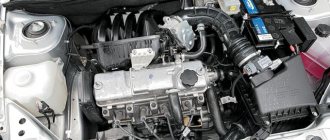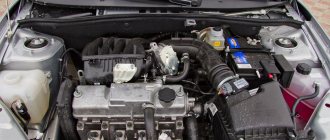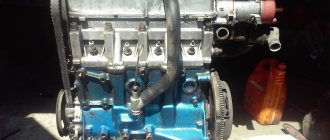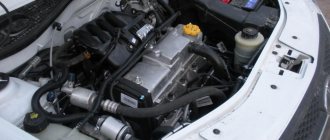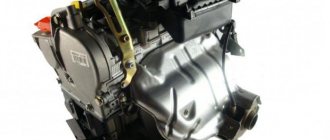Currently, the automotive world is developing very well. The fact is that this is the only way to stay afloat and make a good profit from sales. This applies not only to the vehicles themselves, but also to simple units. For example, the VAZ 2112 engine.
In this article we will talk only about this model of the power unit. After all, it has many features that are inherent not only in Soviet times, but also in the present.
Characteristics of the motor 2112
The main task of the designers when creating the ICE 2112 was to improve the technical characteristics to the world standards that had increased at that time, so a gas distribution scheme with two DOHC camshafts and a four-stroke engine diagram with 16 valves were adopted. For the safety of the valves, pistons with grooves were used by default, which in theory should not bend them if the timing belt breaks.
Design 2112
However, if the first two design solutions in the engine are not satisfactory, then there was a flaw with the pistons that was not corrected by the designers:
- a groove depth of 3 mm and a gasket thickness of 1.3 mm were not enough for a valve stroke of 7.5 mm;
- Due to the “extra” 1.8 mm, the piston bends the valve.
In subsequent modifications, the deficiency was corrected by installing pistons 21124 with a groove depth of 5.5 mm. The basic version of the 21120 motor remained defective, so the engine is characterized by the following performance properties:
| Manufacturer | AvtoVAZ |
| Engine brand | 2112 |
| Years of production | 1998 – 2006 |
| Volume | 1499 cm3 (1.5 l) |
| Power | 68.4 kW (93 hp) |
| Torque moment | 133.3 Nm (at 3400 rpm) |
| Weight | 120 kg |
| Compression ratio | 10,5 |
| Nutrition | injector |
| Motor type | in-line |
| Injection | electronic multipoint |
| Ignition | separate coil for each spark plug |
| Number of cylinders | 4 |
| Location of the first cylinder | TVE |
| Number of valves on each cylinder | 4 |
| Cylinder head material | aluminum alloy |
| Intake manifold | integrated with the receiver, the module is made of polymer |
| An exhaust manifold | exhaust pipe combined with the converter |
| Camshaft | 2 pcs. |
| Cylinder block | cast iron, weight 28.8 kg |
| Cylinder diameter | A class – 82 – 82.01 mm B class – 82.01 – 82.02 mm C class – 82.02 – 82.03 mm D class – 82.03 – 82.04 mm E class – 82.04 – 82.05 mm |
| Pistons | groove 3.5 mm deep |
| Rings | steel 21083-1004029 or cast iron 21083-1000100-10 |
| Piston diameter | A class –81.94 – 81.95 mm B class – 81.95 – 81.96 mm C class – 81.96 – 81.97 mm D class – 81.97 – 81.98 mm E class – 81.98 – 81.99 mm |
| Crankshaft | base from 21083, added torsional vibration damper |
| Number of main bearings | 5 |
| Piston stroke | 71 mm |
| Fuel | AI-95 |
| Environmental standards | Euro-3 |
| Fuel consumption | highway – 5.9 l/100 km combined cycle 7.5 l/100 km city – 9.4 l/100 km |
| Oil consumption | maximum 0.5 l/1000 km |
| Engine oil for 2112 | 5W-30, 5W-40, 10W-40, 15W-40 |
| Engine oil volume | 3.5 l |
| Operating temperature | 90° |
| Motor life | declared 150,000 km, real 250,000 km |
| Adjustment of valves | hydraulic pushers |
| Cooling system | forced, antifreeze |
| Coolant quantity | 7.8 l |
| water pump | with polymer impeller |
| Candles for 2112 | BCPR6ES or AU17DRVM, thread length 19 mm, diameter 14 mm, key 16 mm |
| Gap between spark plug electrodes | 1.1 mm |
| timing belt | DOHC |
| Timing belt | 136 teeth, belt width 25.4 mm |
| Cylinder operating order | 1-3-4-2 |
| Air filter | Nitto, Knecht, Fram, WIX, Hengst |
| Oil filter | with check valve |
| Flywheel | 128 teeth 10.1 mm high, clutch surface size 256.7 mm |
| Flywheel mounting bolts | M10x1.25 mm, length 26 mm |
| Valve stem seals | code 90913-02090 inlet light, code 90913-02088 exhaust dark |
| Compression | cylinder pressure from 12 bar nominal, pressure difference in individual cylinders within 1 bar |
| XX speed | 800 – 850 min-1 |
| Tightening force of threaded connections | spark plug – 30.7 – 39 Nm flywheel – 61 – 87 Nm clutch bolt – 19 – 31 Nm bearing cap – 68 – 84 Nm (main) and 43 – 53 Nm (connecting rod) cylinder head – four stages 20 Nm, 69 – 86 Nm + 90° + 90° |
Information on what oil to use in internal combustion engines is relevant for owners, since hydraulic valve compensators are sensitive to the quality of the lubricant, therefore the manufacturer recommends semi-synthetic engines from Manol, Mobile, Lukoil, Shell and TNK.
Depending on the season, the manual recommends which oil to pour into the engine:
- winter – 5W30 or 5W40;
- summer – 20W30 or 20W40;
- all-season lubricant - 10W30.
Thanks to 5 standard sizes of repair kits for cylinder liners and piston diameters, major repairs can be carried out many times, and the engine is one of the “million-dollar” engines.
Maintainability
The VAZ-21120 impresses with its simplicity of design and high maintainability. There are no problems finding spare parts. They can be easily found in any specialty store. The only “underwater reef” when purchasing the necessary parts is the high possibility of running into a fake. The Chinese manufacturer is especially famous for counterfeit spare parts.
The cast iron cylinder block allows for major repairs of any complexity. At the same time, you can restore the engine in a garage. Car service centers are also happy to take on repair work.
In general, the internal combustion engine of the VAZ-21120 was not entirely successful, but the ease of maintenance and repair largely compensates for this shortcoming. It is important to remember that the service life of the latter depends on the attitude of the car owner towards the engine.
Design Features
Since AvtoVAZ management involved specialists from General Motors (timing) and Porsche (layout) in the design of the 16-valve internal combustion engine, the 2112 engine has the following design solutions:
- the intake valves are controlled by the cams of their own camshaft, the exhaust valves have a separate camshaft;
- oil channels are laid inside the cylinder head;
- floating piston pin fit;
- holes in the block for additional attachments;
- forged steel connecting rods 121 mm long.
Overhaul 2112
A pleasant feature for the owners of these engines are hydraulic pushers, which eliminate the need for periodic valve adjustments with your own hands or at a service station.
Operating principle of hydraulic pushers
Engine modifications
Due to the presence of free space inside the block and cylinder head, immediately after the creation of the basic version of the two-shaft 16-valve engine 2112, its versions began to appear:
- 21124 – boosting the internal combustion engine to 89 hp. With. due to the volume of 1.6 l;
- 21126 – modernization of the engine to a power of 98 hp. pp., volume 1.6 l;
- 21128 – maximum combustion chamber volumes 1.8 liters, power increase to 105 liters. With.
In these versions, the valves do not bend; overhauls are needed much less frequently. The first version was created solely to increase volume and comply with Euro-3 standards. Factory tuning was carried out by increasing the block height to 197.1 mm and increasing the piston stroke.
In the second version, the designers tried to ensure the maximum operational life of the units. For this purpose, special cylinder honing is used using the Federal Mogul method. Block 21126 is gray in color, and the number of classes of repair kits for pistons and cylinder liners has been reduced to three in increments of 0.01 mm.
Version 21128 is not manufactured by AvtoVAZ, but by a third-party manufacturer, ZAO Super-Avto. Engine characteristics have been significantly improved:
- volume 1.8 l;
- torque 162 Nm;
- power 75 kW.
The cylinders are bored by 0.5 mm (diameter 82.5 mm), an original crankshaft has been developed that provides a piston stroke of 84 mm, the width of the rings has been changed to 2 mm (oil scraper), 1.5 mm (lower compression) and 1 mm (upper compression) . The throttle flow area has been increased to 51 mm, Siemens injectors with increased performance have been installed.
There are two more modifications of the ICE 2112:
- 21127 - created in 2013, torque increased to 148 Nm, volume to 1.6 liters, power to 106 hp. With.;
- 21179 is the first option in the manufacturer’s line with a volume of 1.8 liters for Largus and Vesta.
ICE 2127
ICE 21179
In the first version, the problem of floating speed is solved by replacing one MAF (mass air flow) with two sensors DTV (air temperature) and DBP (absolute pressure).
The 21179 motor used a phase shifter for the first time; it was created on the basis of the 21126, therefore it is conventionally considered a modernization of the 2112 generation.
Phase shifter 21179
History of the creation of the VAZ 21124
AvtoVAZ engineers understood that by the time of mass production of domestic 10th generation cars, the power units of the eighth and ninth generation would be very outdated. The trends of the world automotive industry demanded an increase in the power and environmental friendliness of manufactured engines. After all, European manufacturers Volkswagen, Opel, Renault produced engines much more powerful than the domestic AVTOVAZ. But in addition to power, European engines were more economical and environmentally friendly. AvtoVAZ engineers were faced with the task of creating something similar.
There were several ways to get what you wanted. In order to achieve clean exhaust gases, an unconditional decision was made to switch to distributed injection. In addition to the cleanliness of the exhaust, this solution partially solved the issues of increasing power and efficiency.
To obtain the desired power, distributed injection alone was not enough, it was decided to increase the amount of horsepower by increasing the engine size. The volume of 1.6 liters was achieved by increasing the piston stroke to 76.5 mm, which became possible after reconstructing the engine height and using a crankshaft with a large crank. The cylinder diameter has become larger, now it is 82 mm. But this modernization was not enough.
16 valve version
Further improvement in engine performance was possible by installing turbocharging or switching to a BC head, where the number of valves was doubled.
- The first option involved large capital investments and multiple technological innovations.
- The second option was less expensive. Only the cylinder head was modernized; the remaining components and systems of the engine did not require major technical changes. Doubling the number of valves improved the filling of the cylinders with the combustible mixture. This increased torque and power by almost 15 percent. As a result of all the changes, the 1.6 liter engine, which has injection power and a 16-valve head, was able to develop power up to 90 hp.
Improvements from Porsche
It should be noted here that domestic designers had no experience in designing complex structures, which was the BC head. Therefore, AvtoVAZ engineers followed the well-worn path; they turned to well-known specialists from the German concern Porsche, who in the past designed the VAZ 2108 engine for AvtoVAZ.
However, Russian specialists did not sit idle and in parallel carried out work on creating the 16 V cylinder head. As a result, the design proposed by Porsche specialists required a gasket of a very complex shape. The Elring company from Germany offered to solve the issue of creating a gasket. The asking price was almost half a million German marks, which of course did not suit AvtoVAZ representatives. As a result, the issue with the invention of the gasket was solved by specialists from RTI STC for one and a half thousand Soviet rubles.
When completing the design of the 16 V cylinder head, Porsche specialists encountered certain difficulties. We had to involve highly specialized specialists from Italy and Australia. Ultimately, the 16 V cylinder head created for the 10th generation of Volzhsky Automobile Plant engines turned out to be original and multinational, with a unique design. At the same time, the first engines on which this cylinder head was installed had insert wells. And only on the VAZ 21124 engine, in 2004, the 16 V cylinder head, modernized by Russian engineers, received cast spark plug wells, as was originally intended at AvtoVAZ.
Advantages and disadvantages
The cooling system is not fully developed, and the engine’s capabilities are not used, even half:
- experts recognize that the 2112 cylinder head has an impeccable design of the intake and exhaust tract;
- however, the manufacturer equips it with small-diameter valves from previous versions of the internal combustion engine, using the engine’s capabilities by 35 - 40% maximum.
Insufficient valve diameter
At the same time, you can increase the power on your own - you need to carefully bore the holes without damaging the partition, and then select springs and lightweight valves and arrange them inside the cylinder head.
Description
The power unit can be installed on many domestically produced models. This feature can be considered a very big plus, which is not surprising. Indeed, in the event of a breakdown, some parts can be easily replaced by taking them from another vehicle.
It is worth noting that this unit is based on the well-known VAZ 21128 engine, produced back in Soviet times. The designers claim that the technical potential and geometric dimensions are practically no different.
During the design of the power unit, foreign technologies from companies such as Porshe and General motors were used. In detail, together with Motors employees, a completely new distribution injection system for the air-fuel mixture was released. Thanks to this move, it was possible to achieve high efficiency and environmental safety. These factors are very important for the modern automotive world.
Of course, the VAZ 2112 engine also has disadvantages:
- They are mainly associated with insufficient power at low speeds. Experts say that the power unit opens only after 3,500 rpm. It follows from this that the motor is not suitable for all those who love high power and speed.
- The unit also has a weak belt drive and constantly bending valves during a break.
What cars was it used in?
Only three VAZ models using the 2112 engine left the assembly line of the manufacturer's plant:
- 21103 – sedan;
- 21113 – station wagon;
- 2112 – sedan, GLI luxury and Standard versions.
VAZ-2112
Since the characteristics of the engine 21124 and internal combustion engine 21128 are not too different from the original, it was mounted on the same VAZ Lada. The modification of the 21126 engine was equipped exclusively with Prioras.
Reliability
Despite many innovations, the VAZ-21120 ended up not being very successful. Problems with the ignition system, an unfinished CPG and other faults constantly plagued this engine.
However, with competent, gentle operation and timely maintenance, the engine maintained its declared resource, sometimes even significantly exceeding it.
There is evidence that the engine mileage reached 400 thousand km. At the same time, all car owners focused on timely oil changes.
Maintenance
The ergonomic design of the internal combustion engine allows you to service the 2112 engine with the following frequency:
| Maintenance object | Time, year or mileage, 10,000 km (whichever comes first) |
| Timing belt | replacement after 100,000 km |
| Battery | 1/20000 km |
| Valve clearance | 2 /20000 km |
| Crankcase ventilation | 2 /20000 km |
| Belts that drive attachments | 2 /20000 km |
| Fuel line and tank cap | 2 /40000 km |
| Motor oil | 1/10000 km |
| Oil filter | 1/10000 km |
| Air filter | 1 – 2/40000 km |
| Fuel filter | 4 /20000 km |
| Heating/Cooling Fittings and Hoses | 2 /40000 |
| Coolant | 2 /20000 km |
| Oxygen sensor | 1.5/100000 km |
| Spark plug | 1 – 2 /20000 km |
| Exhaust manifold | 2/40000 km |
Unlike coolant, oil partially settles on the walls of the lubrication channels, so with a volume of 3.5 liters, 3.2 liters of a semi-synthetic product is actually required.
Service
This group includes not only changing the engine oil, but also adjusting the valves.
First of all, it’s worth mentioning about the VAZ 2112, the oil change of which should be performed every 15,000 kilometers. Of course, if you replace it a little earlier or a little later, it's okay. The main thing is not to forget about this matter so that the 2112 engine does not starve and fail.
Change of oil
To replace, you will need a few tools and a special container for old oil.
Procedure for draining old oil:
- Unscrew the special plug located under the power unit. To do this, you can use a 17 key or just your hands.
- You need to drain it very carefully so that the oil does not get on the floor or your skin, as it is very hot. If you are careless, you can get a serious burn and other troubles.
- After unscrewing, you should wipe the oil pan and the 2112 engine itself. This is necessary to keep everything clean. We wrap the cork and move on.
- We unscrew the oil filter located under the hood of the car. This action should be done using a special screwdriver or puller.
- After this, you can coat the gasket of the new filter with oil and screw the latter onto the fitting. You need to be very careful about the force applied so as not to damage the thread.
Procedure for filling:
- Remove the cap from the filler neck;
- We take high-quality oil and fill it in an amount of 3.4 liters. You should monitor the level very carefully so that the VAZ 21128 engine receives its amount of special fluid;
- After all this, you can start the power unit and let it run for a few minutes. This is necessary so that the oil passes through all systems and creates a protective film. Next, turn off the unit and check the oil level.
- If it is necessary to add, then add;
- You should also look at the dashboard. If the VAZ 21128 engine is running stably, then the check engine light should not be on.
Adjustment of valves
Now you can move on to the most difficult and interesting part. The fact is that regulating a 16 valve unit is not the easiest thing; special experience is required.
Now there are two ways of adjustment: with the help of a device and without it.
First of all, let's look at the technology using the device:
- Open the valve cover and remove the cover from the timing belt;
- Install a special device designed to regulate the 8 and 16 valve mechanism;
- Set the required marks on the crankshaft and camshaft. This is necessary in order to correctly adjust the valves. Check the timing belt tension. If necessary, tighten it and turn the camshaft several teeth clockwise;
- We check the gap using a feeler gauge;
- We unscrew the washer and look at what is marked on it. Next, we buy a ready-made set of washers and install them instead of the old one.
Without device:
- The first step is to remove the valve covers;
- Raise one of the wheels using a jack;
- Determine where the intake and exhaust valves are located;
- Turn the wheel until one of the crankshaft elbows is on top. We measure the clearance of the first valve;
- Next, you need to calculate which washer will be needed in this case. This action is also necessary when tuning the VAZ 2112 engine is done.
You can calculate the thickness of the washer using a special formula:
- Н = В+(А–С), mm,
- where A is the measured gap;
- B – thickness of the removed washer;
- C – nominal gap;
- N – thickness of the new washer.
Here is a table that will help in adjusting the valves of the VAZ 2112 engine tuning:
| ANGLE AT WHICH THE CRANKSHAFT SHOULD BE TURNED | FISTS | |
| HIGH SCHOOL GRADUATION | INLET | |
| 40-50 | 1 | 3 |
| 220-230 | 5 | 8 |
| 400-410 | 8 | 6 |
| 580-590 | 4 | 7 |
All this allows you to get rid of the tripping of the power unit.
Malfunctions: causes, elimination
The 2112 motor has the following weaknesses in its design:
| Breaking | Cause | Repair |
| Broken timing belt drive, bent valves | 1)shaft wear 2) leaks of shaft seals; 3) pump leaks | diagnostics, replacement of consumables and worn-out parts |
| "Tripling" | 1) ignition problems 2) low compression | 1) replacing spark plugs, wires and coils with a set 2) restoring compression |
| Floating speed | 1) carbon deposits on the throttle valve 2) failure of IAC, TPS, DPKV, Mass air flow sensor | 1) cleaning the damper 2) replacing the sensor |
| Knock | 1)hydraulic compensators 2) pistons 3) main bearings 4) connecting rod bearings | adjustment or replacement |
It is very difficult to independently determine the cause of internal combustion engine vibrations, since special equipment is required.
Other differences
The engines also differ in their “inhalation” design. The 120th intake consists of two aluminum parts: a manifold (“horn”) and a receiver, connected to each other by rubber corrugations. Unit 21124 is “decorated” by an intake system made of plastic and consisting of a single part.
The ignition system is designed differently. The VAZ 2112 is equipped with an ignition distributor module, and on the 21124, individual coils are installed for each cylinder. Due to differences in intake and ignition systems, valve covers also differ.
The 1.6-liter unit has some other differences from its brother: the pressure regulator has been moved from the fuel rail to the pump, the catalyst is located directly at the cylinder head, there are 2 oxygen sensors (Euro-3) instead of one (Euro-2) for the 1.5 liter. The split timing case design makes it easy to replace the timing belt.
People often ask: where is the serial number of the engine on the VAZ 2112? Indeed, the number located under the air filter is quite difficult to detect. It is located at the rear end of the BC, under the thermostat housing. To find the required numbers, you need to release the air filter mount and tilt it slightly to the side.
If corrosion makes it difficult to read the serial designation, you should use fine abrasive sandpaper and then wash the area with WD-40.
Engine tuning
Before tuning, you should take into account the design nuances that the 2112 engine has:
- chipping in this case is useless;
- install a Stolnikov 8.9, STI-2 or STI-3.1 camshaft;
- replace the throttle with 54 - 56 mm;
- mount the exhaust tract with spider 4/2/1.
Camshaft Stolnikov
Thus, ICE 2112 is the 5th generation of AvtoVAZ engines with a four-stroke cycle. In the basic version, the design is flawed (the valves bend); this error is corrected in the modifications.
If you have any questions, leave them in the comments below the article. We or our visitors will be happy to answer them
Technical data VAZ 21124
VAZ 21124 is a four-stroke gasoline engine with an injection power system. The four cylinders of the internal combustion engine are arranged in one row. The location in the engine compartment is transverse. The material used to make the BC is highly durable cast iron.
- The gas distribution system has two camshafts and 16 valves, 4 per cylinder.
- The exact engine capacity is 1599 cc. cm.
- The piston has a stroke length of 75.6 millimeters and its diameter is 82 mm.
- The torque of the internal combustion engine 21124 at 3700 rpm is 131 Nm. The power of this internal combustion engine is 89 hp. Compression ratio 21124 - 10.3:1.


